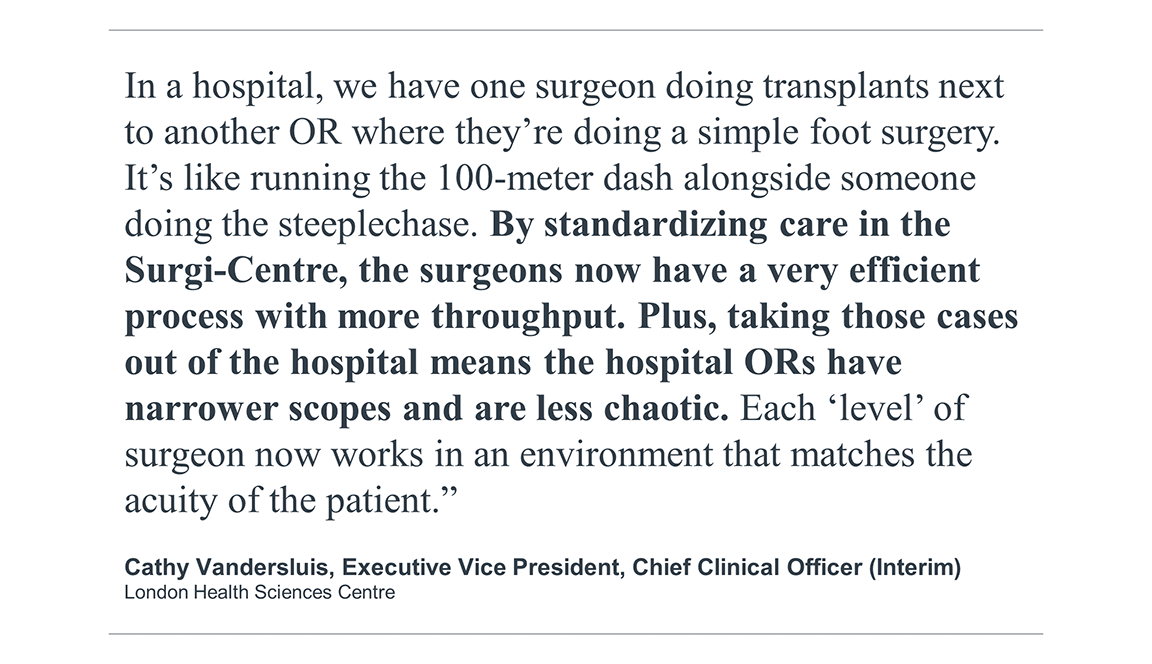Overview
The challenge
London Health Sciences Centre (LHSC), like many Ontario teaching hospitals, faced significant demographic, capacity, and financial pressures over the last decade. These pressures resulted in multi-month wait times for elective surgery, as well as for specialist surgical consults.
The organization
LHSC is a multi-site, public health system located in Ontario, Canada. It has a combined capacity of 1,000 beds across all facilities.
The approach
LHSC adapted a 10,000-square foot space into its new ambulatory surgical center (ASC). The ASC, called the Surgi-Centre, delivers select, low-acuity ambulatory surgical procedures on a strictly outpatient basis. It opened in March 2020, consisting of 2 ORs and 10 pre/postsurgical beds, with capacity to treat 8 to 15 surgical patients per day.
The result
LHSC's Surgi-Centre is the first ASC of its kind in Ontario, Canada. It has demonstrated 56% lower case costs based on human resources, disposables, and anesthesia costs for low-complexity procedures on low-risk patients at LHSC, while simultaneously expanding surgical capacity.
How LHSC took a deliberative approach to transitioning care from hospital to ASC
Creating the Surgi-Centre allowed LHSC to shift low-intensity, low-resource surgical procedures from its main acute site to an ambulatory surgical center. LHSC accomplished this shift, maintained a high level of clinical quality and engagement among staff, and reduced surgical operating costs to the system.
The three strategies
LHSC’s site-of-care-shift from traditional, acute hospital to an ambulatory surgical center was achieved through a unique approach: ensuring quality by real-world testing the “shift concept” within existing sites of care, preparing physicians and clinical staff to operate in a new care setting through an audition-like process, and boosting staff engagement through an “entrepreneur-oriented” approach to operational feedback.
Ambulatory surgical centers (ASCs) are almost nonexistent within the Canadian health care landscape. So, informed by literature research and visits to ASCs in the United States, LHSC opted for a slow-testing and buy-in process to demonstrate the viability of the Surgi-Centre model. The benefit of the proposed model was that it would enable higher throughput of low-acuity surgical procedures with lower resource utilization than inpatient care. This increased volume of cases, coupled with standardized procedures and fewer preferential tools at the surgeon’s disposal, caused some anxiety among clinical stakeholders who worried that quality would be compromised. LHSC employed “real-world testing” to secure buy-in from surgeons and surgical staff, verify that clinical quality could be maintained, and ensure that select surgical procedures could be performed safely at lower cost.
Surgi-Centre pilot program uses real-world conditions to mimic proposed site-of-care shift changes
LHSC’s shift of low-acuity surgical procedures to the Surgi-Centre took place over a multiyear period where the idea was developed and then, crucially, tested. Spearheaded by a working group composed of the medical director of the ASC, service line leaders, perioperative director, surgical specialists, and patients, LHSC implemented its orthopedic trauma pilot program to investigate which surgical procedures corresponded to the standard of low-resource-intensity, high-throughput care. Starting in 2016, on assigned days over a four-year period, an underutilized OR within the main hospital was modified to pilot a new ambulatory model of care that LHSC envisioned.
Among the pilots LHSC conducted were what surgical procedures could be safely transitioned from general anesthesia to regional anesthesia. The organization also conducted a risk assessment of which low-acuity procedures could be transitioned to an ASC model while maintaining high quality of care while simultaneously increasing surgical throughput.
Additionally, on the OR pilot days, surgeons gradually pared down the surgical tool suite of 80 tools to just 20. The goal was to understand if limiting surgical tools impacted quality, as reducing and standardizing what tools the Surgi-Centre was equipped with offered LHSC a substantial cost-saving opportunity. Within the resource-scarce pilot environment, surgeons were able to maintain quality and even do so with smaller teams because of the ability to “self-service” with a pared-down toolset and predictable low patient acuity. So, when the Surgi-Centre opened, surgeons were comfortable with the new environment because they had already worked in a similar situation and had seen this model work.
‘High-throughput’ model requires definition of who qualifies as a low-acuity patient
LHSC’s real-world tests demonstrated the viability of a low-resource, high-throughput Surgi-Centre model. The organization then developed a new system of stratifying surgical patients by complexity.
Surgical patients at LHSC are now stratified into different tiers based on patient complexity and their treatment’s resource intensity. Tier 1 refers to low-complexity patients requiring surgical procedures that are low in resource intensity, while Tier 3 refers to the highest-complexity patients requiring the most resource-intense surgical treatment. Most patients fall in Tier 1 and Tier 2A.
The Surgi-Centre’s two ORs are set up each day to cater exclusively to one tier of patient—ideally, even to one type of procedure. Such standardization extends to staffing: tier 1 procedures do not have a scrub nurse, while all procedures in tiers 2 and 3 are performed with a staffing complement of no more than 2.5 nurse FTEs.
| Tier 1 | Tier 2A | Tier 2B | Tier 3 | |
|---|---|---|---|---|
Share of Surgi-Centre staff | 20% | 40% | 40% | 0% |
Location | Entirely in Surgi-Centre if patient and surgeon meet audition requirements | Cases divided between ASC and hospital by capacity and if patient and surgeon meet audition requirements | Cases divided between ASC and hospital by capacity and if patient and surgeon meet audition requirements | Cases divided between ASC and hospital by capacity and if surgeon meets audition requirements |
Example of patients/cases | Distal extremities, foot procedures, carpal tunnel | Knee/hip arthroscopy, hernias, fusions, ACL repairs | Intra-abdominal procedures (gall bladder, AV fistula, etc.) | Total hip replacement |
Note: See pages 15 and 16 of the PDF for the full list of procedures performed at the Surgi-Centre.
Stratifying patients into tiers enables block scheduling of common procedures that dramatically boosts throughput while simultaneously minimizing cost and reducing variability.
The scale of this change—and its successful implementation—would not have been possible had LHSC not taken a slow, deliberate approach at “real-world testing” the operational aspects of their proposed shift. LHSC engaged and consulted with clinicians throughout the development of the Surgi-Centre. This engagement allowed clinicians on the front line to determine what procedures could be safely performed at the ASC.
Just as it was vital to test the clinical quality concerns before shifting care to the Surgi-Centre, it was equally vital to test clinicians before shifting their practice to a new site of care. So, just as LHSC tested the pared-down and standardized infrastructure that they intended to use at the Surgi-Centre before formally opening it, they also tested the people who would be delivering that care.
A new work philosophy for surgeons looking to operate at the Surgi-Centre
Traditionally, a surgeon in an OR is given a wide degree of autonomy in running the OR, with support staff in practice adapting to the preferences/styles of the surgeon. However, leaders at LHSC understood that to enable high-throughput, lower-cost care within the Surgi-Centre model, surgeons would have to accept an increased amount of standardization in the way they worked. This necessitated a mind shift among surgeons who wanted to work in the Surgi-Centre.
Interested surgeons first had to meet with the ASC’s medical director and the ASC’s clinical manager for an interview where they reviewed a new employment contract for onboarding surgeons. This contract outlined the different expectations regarding behavior and the ASC’s unique team environment: everything from greater self-service, to working with a smaller team, to accepting nurses who circulate between ORs for Tier 1 procedures, to working with a standardized set of surgical tools. Only after having these initial conversations and reviewing the contract do surgeons get the chance to formally “audition” to work in the Surgi-Centre.
An ‘audition’ process to work at the Surgi-Centre
Prior to the audition, a surgeon will receive detailed information about ASC operating procedures. The audition itself takes place as a two-day pilot where that surgeon’s hospital OR day is reduced to 50% to 75% of normal volumes, while the number of “easy throughput” surgical procedures is gradually increased. This artificial pressure is designed to test whether a surgeon is capable of operating in an environment with an increased level of standardization and high throughput, where a Surgi-Centre OR can safely see more procedures per day as opposed to a traditional hospital OR. A debrief at the end of the two-day pilot serves as the final decision on whether a surgeon is fit to operate at the Surgi-Centre.
Give clinicians the opportunity to become specialists in their preferred delivery model
LHSC leaders emphasized that not everyone succeeds during their audition. Some surgeons who value autonomy or aren’t interested in fast-paced, low-complexity caseloads might not even choose to apply. Others don’t feel comfortable working in an environment with increased standardization, while some need more resources or a larger team around them to feel comfortable while operating.
These different preferences combine to set up each surgeon to become specialist within their preferred site of care. The Surgi-Centre’s standardization of patients into tiers ensures that all surgeons are operating in an environment that is more predictable than the typical hospital OR, which in turns enables them to better hone their skills as high-volume procedurist. Conversely, those who wish to remain in the main hospital are better suited to practice high-complexity cases.

Ensuring that clinical quality could be sustained at the Surgi-Centre didn’t end with the successful completion of the pilot program. A core part of how the Surgi-Centre continues to maintain high standards of clinical quality while lowering cost and enabling high throughput is by providing each staff member an equal opportunity to positively impact the way the Surgi-Centre is run.
This “innovation authority” is effectively devolved to the entirety of the Surgi-Centre staff through an end-of-day team huddle. This daily huddle includes all staff present in the Surgi-Centre each day: clinical leaders, nurses, surgeons, support workers, and environmental service staff.
The huddles are a carry-over from the pilot program. Each day that the orthopedic trauma pilot performed surgery in its designated OR, the entire OR team debriefed the full day’s experiences using a standard debrief format. The basic message communicated through these huddles was that LHSC viewed each worker as critical to its mission of ensuring that the proposed site-of-care shift could maintain the same quality of care seen in the hospital OR. Indeed, by embedding the daily huddles into the operational framework of the Surgi-Centre, LHSC ensured that the site-of-care-shift was both empowering from an engagement standpoint and transformative from an operational standpoint.
Format of a daily huddle debrief drives staff to innovate around patients
The daily huddle debrief begins with a short summary of the number and type of surgeries performed in each of the two Surgi-Centre ORs. The format of the debrief is structured to follow the patient journey through the Surgi-Centre:
- Registration
- Pre-operative care
- Block room/anesthesia
- Operating room
- Post-operative care and auxiliary
As each area is addressed, staff are asked to reflect on that day’s operations and provide suggestions for improvement. These suggestions are captured in a debrief document that includes a final section on decision points, ensuring that suggestions are considered and acted upon in a timely fashion. The huddles conclude by sharing feedback from that day’s patients, which is almost always positive. As such, the daily huddle ends with a powerful opportunity to recognize the collective work of the Surgi-Centre by providing tangible, real feedback from that day’s patients.
While the structure of the huddles is relatively straightforward, the fact that they occur every day means that the Surgi-Centre is in a state of continuous innovation. In fact, this everyday approach was modeled partly off similar huddles at Honda automotive plants, where any worker could, and was encouraged to, offer improvements to the daily running of the plant at their end-of-day huddles. By creating a platform where everyone is viewed as equal in their ability to propose effective solutions and innovations, LHSC ensures that clinical quality is the shared responsibility of all Surgi-Centre workers.
Note: See pages 17 and 18 of the PDF for an example of a daily huddle debrief.
How we know it’s working
The goal of the Surgi-Centre was to simultaneously help LHSC expand capacity, cut surgical wait times, and dramatically reduce surgical costs, while improving the patient experience.
- Expanded capacity: The Surgi-Centre has a forecasted surgical capacity of 2,400 per year. The model has been so successful that there is active discussion about creating additional capacity at the site.
- Complete shift of certain surgical procedures: Certain surgical procedures are now conducted exclusively at the Surgi-Centre, freeing up capacity within acute-site ORs. Examples are listed below.
- Orthopedic trauma: foot and ankle
- Sports medicine: Knees and shoulder arthroscopy as well as knee/shoulder ligament repair, tendon repairs
- General surgery: Hernia repairs
- Reconstructive surgery, insured: Breast reductions, mastopexies
- Reconstructive surgery, uninsured: 360-degree body contouring, liposuction, breast augmentation
- Reduced surgical costs: During the initial proof of concept phase in 2016, the average cost per case was based on three factors: human resources, disposables and anesthesia costs. Total costs for Tier 1 procedures were 56% lower in the Surgi-Centre than in the hospital OR. Costs for Tier 2 procedures were 30-34% lower.
- Improved patient experience: Comparative patient surveys indicate that patient experience scores are noticeably higher for procedures conducted at the Surgi-Centre than at the hospital. ASC patients spend on average 82.5 minutes less in post-op recovery at the Surgi-Centre than they do in a hospital OR. Additionally, readmission rates for Surgi-Centre patients are quite low. Less than 1% of patients who receive a surgical procedure at the Surgi-Centre are operated on again within two weeks of their original surgery.
Average number of minutes saved in post-op recovery for ASC patients at the Surgi-Centre compared to hospital OR
Don't miss out on the latest Advisory Board insights
Create your free account to access 1 resource, including the latest research and webinars.
Want access without creating an account?
You have 1 free members-only resource remaining this month.
1 free members-only resources remaining
1 free members-only resources remaining
You've reached your limit of free insights
Become a member to access all of Advisory Board's resources, events, and experts
Never miss out on the latest innovative health care content tailored to you.
Benefits include:
You've reached your limit of free insights
Become a member to access all of Advisory Board's resources, events, and experts
Never miss out on the latest innovative health care content tailored to you.
Benefits include:
This content is available through your Curated Research partnership with Advisory Board. Click on ‘view this resource’ to read the full piece
Email ask@advisory.com to learn more
Click on ‘Become a Member’ to learn about the benefits of a Full-Access partnership with Advisory Board
Never miss out on the latest innovative health care content tailored to you.
Benefits Include:
This is for members only. Learn more.
Click on ‘Become a Member’ to learn about the benefits of a Full-Access partnership with Advisory Board
Never miss out on the latest innovative health care content tailored to you.


